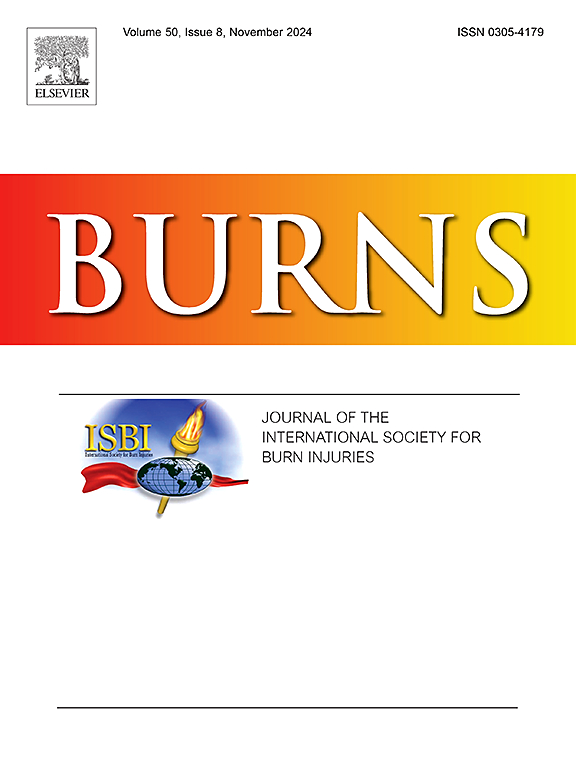住院烧伤患者的 DSM-5 急性应激障碍:创伤前后心理风险因素的影响和相互作用。
IF 3.2
3区 医学
Q2 CRITICAL CARE MEDICINE
引用次数: 0
摘要
目的:烧伤具有创伤性,可导致心理后遗症,尤其是急性应激障碍(ASD)。关于符合DSM-5标准的ASD患病率和危险因素的信息在烧伤和其他创伤幸存者中相对有限。本研究旨在根据DSM-5标准调查烧伤后可能的ASD患病率,并探讨创伤前和创伤后心理危险因素对DSM-5 ASD症状的影响和相互作用。方法:选取2017年2月至2020年11月在台湾最大的烧伤中心住院的118例患者,其中100例在急性住院期间损伤后30天内完成评估。大多数参与者为男性(73% %),平均年龄为41.9±12.5岁。烧伤总体表面积(TBSA)的平均百分比为15.1±11.5%。结果:约9%的住院烧伤患者可能患有DSM-5 ASD。最常见的ASD症状是侵入性记忆、创伤提醒引发的痛苦和痛苦的梦。经协变量调整后,创伤前和创伤后心理危险因素占DSM-5烧伤后ASD症状变异的42.4%。创伤前后情绪和创伤前后分离都是具有中大型效应的强预测因子(半偏r2 =)。13和0.09)。值得注意的是,先前的抑郁严重程度显著降低了创伤周围心理危险因素与烧伤后ASD症状之间的关联(增量R2 = 5.6- 8.8%)。结论:研究结果强调了创伤前和创伤后心理过程在烧伤后ASD症状易感性中的相互作用。本文章由计算机程序翻译,如有差异,请以英文原文为准。
DSM-5 acute stress disorder in hospitalized burn patients: The impact and interplay of pre- and peri-trauma psychological risk factors
Objective
Burn injuries can be traumatic and lead to psychological sequelae, particularly acute stress disorder (ASD). Information regarding the prevalence and risk factors of ASD following DSM-5 criteria is relatively limited among survivors of burn and other traumas. This study aimed to investigate the prevalence of probable ASD post-burn according to DSM-5 criteria and explore the impact and interplay of pre- and peri-trauma psychological risk factors on DSM-5 ASD symptomatology.
Methods
Between February 2017 and November 2020, 118 patients admitted to the largest burn center in Taiwan were enrolled, with 100 completing assessments within 30 days of injury during acute hospitalization. Most participants were men (73 %), with a mean age of 41.912.5 years. The average percentage of total body surface area (TBSA) burned was 15.111.5 %.
Results
Around 9 % of the hospitalized burn patients had probable DSM-5 ASD. The most common ASD symptoms were intrusive memories, distress triggered by trauma reminders, and distressing dreams. Pre- and peri-trauma psychological risk factors uniquely accounted for 42.4 % of the variance in DSM-5 ASD symptomatology post-burn after adjusting for covariates. Both peritraumatic emotions and peritraumatic dissociation emerged as strong predictors with medium-to-large effect sizes (semi-partial r2 =.13 and .09). Notably, prior depression severity significantly moderated the associations between peri-trauma psychological risk factors and ASD symptoms post-burn (incremental R2 = 5.6–8.8 %).
Conclusion
The findings underscore the interplay of pre- and peri-trauma psychological processes in susceptibility to ASD symptomatology post-burn.
求助全文
通过发布文献求助,成功后即可免费获取论文全文。
去求助
来源期刊

Burns
医学-皮肤病学
CiteScore
4.50
自引率
18.50%
发文量
304
审稿时长
72 days
期刊介绍:
Burns aims to foster the exchange of information among all engaged in preventing and treating the effects of burns. The journal focuses on clinical, scientific and social aspects of these injuries and covers the prevention of the injury, the epidemiology of such injuries and all aspects of treatment including development of new techniques and technologies and verification of existing ones. Regular features include clinical and scientific papers, state of the art reviews and descriptions of burn-care in practice.
Topics covered by Burns include: the effects of smoke on man and animals, their tissues and cells; the responses to and treatment of patients and animals with chemical injuries to the skin; the biological and clinical effects of cold injuries; surgical techniques which are, or may be relevant to the treatment of burned patients during the acute or reconstructive phase following injury; well controlled laboratory studies of the effectiveness of anti-microbial agents on infection and new materials on scarring and healing; inflammatory responses to injury, effectiveness of related agents and other compounds used to modify the physiological and cellular responses to the injury; experimental studies of burns and the outcome of burn wound healing; regenerative medicine concerning the skin.
 求助内容:
求助内容: 应助结果提醒方式:
应助结果提醒方式:


